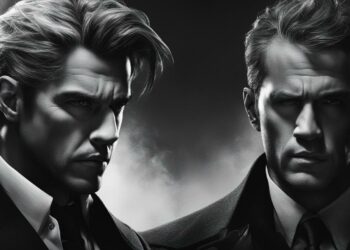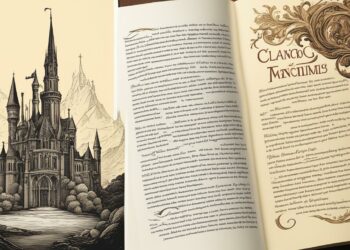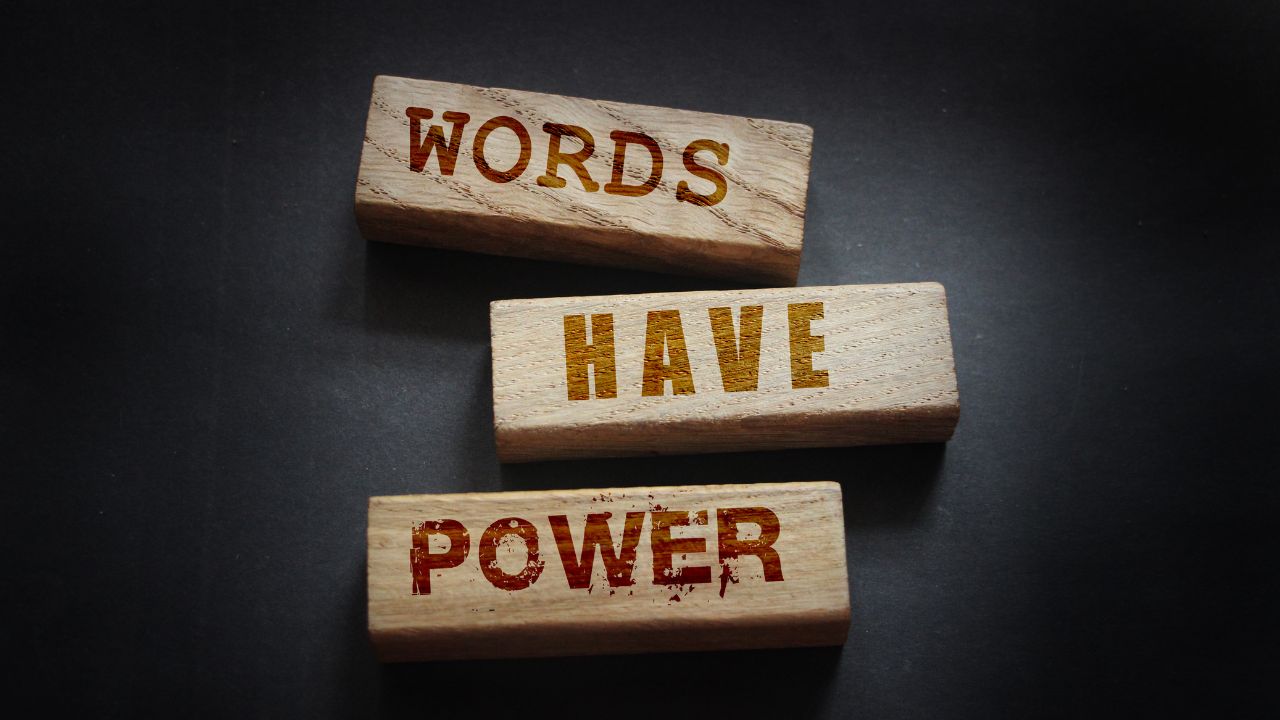Have you ever wondered why certain stories resonate with us on a deep level? Why do we find comfort in familiar narratives, despite the vast differences in culture, time, and context? The answer lies in situational archetypes in literature, the underlying patterns that reflect universal human experiences.
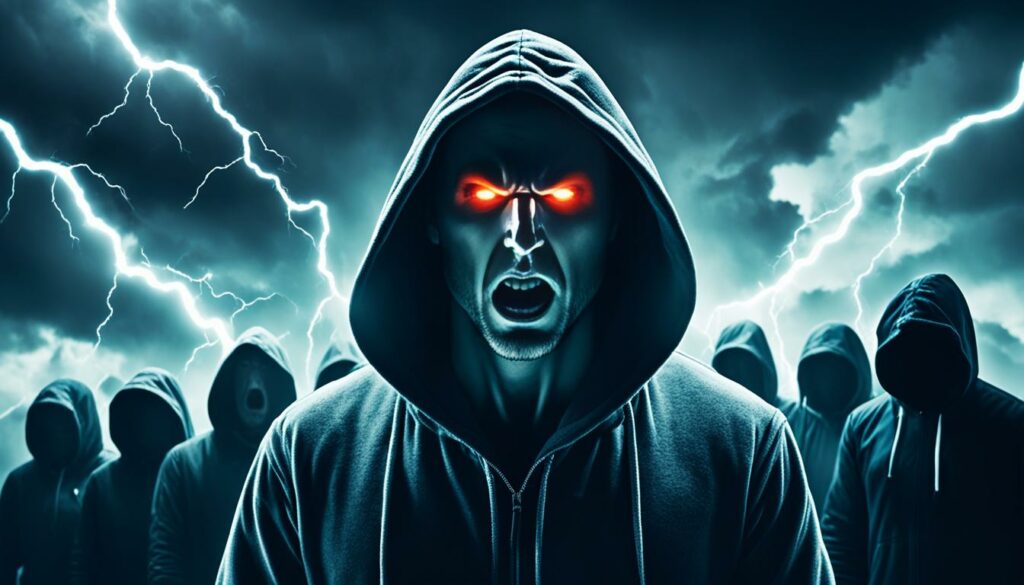
From the hero’s journey to the star-crossed lovers, these archetypes provide a framework for storytelling and connect us to the essence of what it means to be human. They transcend time and geographical boundaries, weaving together narratives that speak to our shared emotions, aspirations, and struggles.
In this article, we will embark on a journey to understand situational archetypes in literature. We will explore the significance of character archetypes, delve into the hero’s journey, and unravel the meanings behind symbolic archetypes. Along the way, we’ll encounter fascinating examples from beloved books and movies, shedding light on the power of storytelling to captivate and move us.
Key Takeaways:
- Discover the patterns and recurring themes that exist in literature through situational archetypes.
- Understand the significance of character archetypes and symbolic archetypes in storytelling.
- Explore the hero’s journey and the archetypal characters that embody this narrative structure.
- Unveil the deeper meanings behind symbolic archetypes using examples from popular works.
- Examine the role of stock characters and common archetypes in adding depth to stories.
Understanding Archetypes in Literature
In the world of literature, archetypes are recurring patterns and themes that exist across different stories. They serve as fundamental building blocks, representing universal concepts and reflecting common human experiences. Before we delve into the realm of situational archetypes, it is crucial to have a basic understanding of two primary types: character archetypes and symbolic archetypes.
Character Archetypes
Character archetypes are recurring personas that represent specific traits or roles commonly found in literature. These archetypes are often associated with certain qualities, motivations, and behaviors, reinforcing particular narrative elements. Here are some common character archetypes:
- The Hero: The hero archetype embodies courage, bravery, and the quest for justice. This character type often embarks on challenging journeys and inspires change.
- The Villain: The villain archetype opposes the hero and represents evil, chaos, and destructive tendencies. They create conflict and obstacles for the protagonist.
- The Mentor: The mentor archetype guides and supports the hero, offering wisdom, advice, and supernatural abilities. They help shape the hero’s path and prepare them for their journey.
- The Trickster: The trickster archetype is characterized by their cunning, wit, and ability to deceive. They add humor and unpredictability to the story, often challenging or disrupting the hero’s plans.
Symbolic Archetypes
Symbolic archetypes are objects, settings, or events that carry deeper meanings, often representing universal concepts or ideas. These archetypes provide layers of symbolism and evoke emotional responses from readers. Here are some examples of symbolic archetypes:
The Journey: The journey archetype represents personal growth, self-discovery, and transformation. It signifies the protagonist’s quest for knowledge, enlightenment, or a physical destination.
In literature, character archetypes and symbolic archetypes work together to create rich, multidimensional stories. They contribute to the depth and meaning of a narrative, allowing readers to connect with the themes and messages conveyed by the author.
| Character Archetypes | Symbolic Archetypes |
|---|---|
| The Hero | The Journey |
| The Villain | The Quest |
| The Mentor | The Threshold |
| The Trickster | The Symbolic Battle |
The Power of Archetypes
Understanding character archetypes and symbolic archetypes in literature allows us to recognize familiar patterns and meanings. It helps us make connections between different stories and deepens our appreciation for the human experience. By leveraging archetypes, authors can tap into our collective knowledge, evoke powerful emotions, and craft compelling narratives that resonate with readers.
The Hero’s Journey: A Classic Situational Archetype
The hero’s journey is a widely recognized situational archetype that forms the backbone of many adventure stories. It is a narrative structure that follows the hero’s transformative journey, from their ordinary world to a realm of trials and challenges, ultimately leading to their return as a changed individual.

The hero archetype, often portrayed as a brave and noble figure, embarks on this epic adventure, facing tests and overcoming obstacles that represent the universal human experience of growth and self-discovery. This archetypal character resonates with readers because it reflects our innate desire for personal transformation and triumph against adversity.
The essential elements of the hero’s journey include the call to adventure, the mentor figure, the crossing of the threshold, trials and tribulations, the ultimate confrontation with a great challenge, and the hero’s return with newfound wisdom and power. These stages create a compelling narrative arc that captivates audiences and leaves a lasting impact.
“The hero’s journey is a mirror that reflects our own desire for self-discovery and transformation.”
Throughout literature, numerous examples of the hero’s journey can be found. From ancient myths like the story of Odysseus in Homer’s The Odyssey to modern-day tales like J.K. Rowling’s Harry Potter series, adventure stories often follow this archetypal structure, drawing readers into a world of excitement, growth, and self-realization.
Examining Archetypal Characters in the Hero’s Journey
Within the hero’s journey, specific archetypal characters serve significant roles in guiding and challenging the hero. The mentor figure, such as Obi-Wan Kenobi in Star Wars or Gandalf in The Lord of the Rings, provides wisdom and guidance to the hero, assisting them in their transformational journey.
Another notable archetypal character is the threshold guardian, who presents obstacles and tests for the hero to overcome. These characters could take the form of a mythical creature or a rival who challenges the hero’s progress. Think of the dragon in the story of Beowulf or the wicked witch in The Wizard of Oz.
The trickster, often portrayed as a mischievous character, adds humor and unpredictability to the hero’s journey. Examples include characters like Bugs Bunny in Looney Tunes or Loki in Norse mythology.
By examining these archetypal characters within the hero’s journey, we gain a deeper understanding of the underlying themes and symbolism that enriches the adventure story genre.
| Archetypal Character | Function | Example |
|---|---|---|
| Mentor | Guides and supports the hero | Obi-Wan Kenobi in Star Wars |
| Threshold Guardian | Creates obstacles for the hero | Dragon in the story of Beowulf |
| Trickster | Brings humor and unpredictability | Bugs Bunny in Looney Tunes |
The hero’s journey and its archetypal characters continue to be prominent features in literature, capturing the imagination of readers across cultures and generations. Its timeless appeal lies in its ability to reflect our own desires for growth, transformation, and the triumph of good over evil.
Mentor Archetype: Guiding the Hero’s Life
The mentor archetype plays a crucial role in the hero’s journey, providing guidance and wisdom. Throughout literature and popular culture, we see numerous examples of mentors shaping and influencing the paths of heroes. Two iconic franchises, Star Wars and Lord of the Rings, offer exceptional illustrations of the mentor archetype and its profound impact on the hero’s life.
The Force Awakens: Obi-Wan Kenobi, Yoda, and Luke Skywalker
In the Star Wars saga, we encounter several mentor figures who guide the hero’s journey. The wise and venerable Obi-Wan Kenobi mentors both Anakin Skywalker and later Luke Skywalker, imparting invaluable knowledge and teaching the ways of the Force. Yoda, the ancient and revered Jedi Master, continues this tradition by serving as Luke’s mentor, providing spiritual guidance and helping him embrace his true potential. Luke Skywalker himself assumes the role of a mentor in later films, passing on his wisdom and teachings to a new generation of heroes.
Through the mentor archetype, Star Wars showcases the importance of guidance and the transfer of knowledge to ensure the hero’s growth and understanding of their destiny.
The Fellowship of the Ring: Gandalf the Grey
In the Lord of the Rings trilogy, Gandalf the Grey embodies the mentor archetype. As a powerful wizard, he plays a central role in guiding the members of the Fellowship of the Ring. Gandalf provides wisdom, protection, and guidance, assisting Frodo and his companions in their perilous journey to destroy the One Ring. His counsel and leadership not only aid their physical journey but also strengthen their resolve and character, ultimately leading to the success of their mission.
Gandalf’s role as a mentor demonstrates the transformative power of guidance and the instrumental role mentors play in shaping the hero’s destiny.
“A mentor is someone who allows you to see the hope inside yourself.” – Oprah Winfrey

The mentor archetype in literature, as exemplified by Star Wars and Lord of the Rings, highlights the profound impact mentors have on the hero’s life. They guide, teach, and provide the necessary tools for the hero to overcome challenges and fulfill their destiny. The mentor archetype serves as a beacon of wisdom and inspiration, igniting the hero’s journey towards greatness.
Symbolic Archetypes: Unveiling Deeper Meanings
Symbolic archetypes are a powerful tool in literature, imbued with profound significance that represents universal concepts. These archetypes add depth and complexity to stories, allowing readers to connect with deeper meanings and themes. In this section, we will examine examples from two iconic series – The Lion King and the Harry Potter series – to uncover the symbolic archetypes embedded within their narratives.
The Lion King: A Tale of Transformation
In Disney’s The Lion King, the circle of life serves as a central symbolic archetype. It represents the cyclical nature of existence, emphasizing the interconnectedness of all living beings. Moreover, the lion itself holds symbolic meaning, embodying strength, courage, and leadership. Simba’s journey from a naive cub to a wise and responsible king mirrors the universal theme of personal growth and transformation.
“The past can hurt. But the way I see it, you can either run from it or learn from it.” – Rafiki
This quote from Rafiki, the wise and insightful mandrill in The Lion King, highlights the importance of embracing the past and the lessons it holds. It serves as a reminder that personal growth and transformation often require confronting one’s fears and past mistakes, ultimately leading to self-discovery and wisdom.
The Harry Potter Series: A Battle of Light and Dark
In J.K. Rowling’s Harry Potter series, the battle between good and evil is a prominent symbolic archetype. The conflict between Harry and Lord Voldemort represents the timeless struggle between light and dark, exploring themes of courage, sacrifice, and the triumph of love over hatred. The iconic symbol of the lightning-shaped scar on Harry’s forehead becomes a powerful representation of his connection to both the darkness he has faced and the light within him.
The Harry Potter series also features the archetypal mentor figure, Albus Dumbledore. As the wise and enigmatic headmaster of Hogwarts School of Witchcraft and Wizardry, Dumbledore guides Harry and other young wizards through their respective journeys, imparting invaluable wisdom and moral guidance.
“It is our choices, Harry, that show what we truly are, far more than our abilities.” – Albus Dumbledore
This quote from Dumbledore highlights the importance of personal choices and the impact they have on shaping one’s character. It underlines the symbolic archetype of personal agency and the ability to choose between good and evil, ultimately determining one’s path and destiny.

| The Lion King | Harry Potter Series |
|---|---|
| The circle of life | The battle between good and evil |
| The lion – strength and leadership | The lightning-shaped scar – light and darkness |
| Simba’s transformation | Harry’s journey of self-discovery |
| Rafiki as the wise mentor | Dumbledore as the guiding mentor |
Exploring Stock Characters and Archetypal Characters
In literature, stock characters and common archetypes play vital roles in adding depth and flavor to stories. These character types often embody specific traits or serve particular narrative functions, contributing to the overall richness of a literary work.
One common example of a stock character is the comic relief. This character type is known for providing humor and light-heartedness in contrast to more serious or dramatic plotlines. The comic relief character offers a welcome respite from tension, allowing readers to temporarily escape the intensity of the story. They often appear in comedies or even in darker narratives to provide moments of levity and relief.
“I cannot but conclude the bulk of your natives to be the most pernicious race of little odious vermin that nature ever suffered to crawl upon the surface of the earth.”
– Gulliver’s Travels by Jonathan Swift
Another intriguing character type is the one with educated stupidity. These characters might possess extensive knowledge or education but often lack common sense or practicality. They bring humor and irony to the narrative through their unintentional foolishness. From Don Quixote to Mr. Bean, these characters challenge conventional wisdom and offer witty insights into the human condition.
Character archetypes, on the other hand, represent broader patterns and roles that appear across different stories and genres. They embody common human experiences and fulfill specific functions within the plot. The hero, the villain, the wise mentor, and the love interest are examples of character archetypes consistently found in literature.
While stock characters and character archetypes provide a sense of familiarity, writers often infuse them with unique traits and backgrounds, making them dynamic and engaging. These characters serve as a foundation upon which complex narratives are constructed, creating compelling stories that resonate with readers.
The Use of Stock Characters and Archetypes in Literature
The utilization of stock characters and archetypal characters in literature goes beyond clichés or predictability. They act as powerful tools for storytellers to convey messages, explore themes, and tap into universal human experiences.
Their prevalence in literature showcases their effectiveness in capturing readers’ attention and fostering a sense of connection. Readers can easily identify and relate to these characters, as they reflect common aspects of the human condition. Through stock characters and character archetypes, authors can explore complex ideas, provoke emotions, and create memorable narratives.
Comparing Stock Characters and Character Archetypes
| Stock Characters | Character Archetypes |
|---|---|
| Often limited in depth and development | Can be complex and multi-dimensional |
| Provide specific functions or roles within a story | Represent broader patterns and universal experiences |
| Bring humor, lightness, or intensity to the narrative | Contribute to the overall plot structure and themes |
| Commonly used in various genres and storytelling traditions | Appear across different cultures and time periods |
The use of stock characters and character archetypes exemplifies the intricate interplay between storytelling and the human experience. By employing these narrative elements effectively, authors create captivating tales that resonate with readers and offer valuable insights into the complexity of life.

Situational Archetype Examples in Popular Literature
By analyzing examples from popular literature such as Romeo and Juliet, Star Wars, Harry Potter, and the Indiana Jones series, we can uncover various situational archetypes that contribute to engaging storytelling and captivate readers.
“A pair of star-crossed lovers take their life…” – William Shakespeare, Romeo and Juliet
In the tragic love story of Romeo and Juliet, the concept of star-crossed lovers is an archetypal motif that signifies the forbidden and doomed nature of their relationship. Their love transcends societal boundaries but is ultimately shattered by a cruel twist of fate.
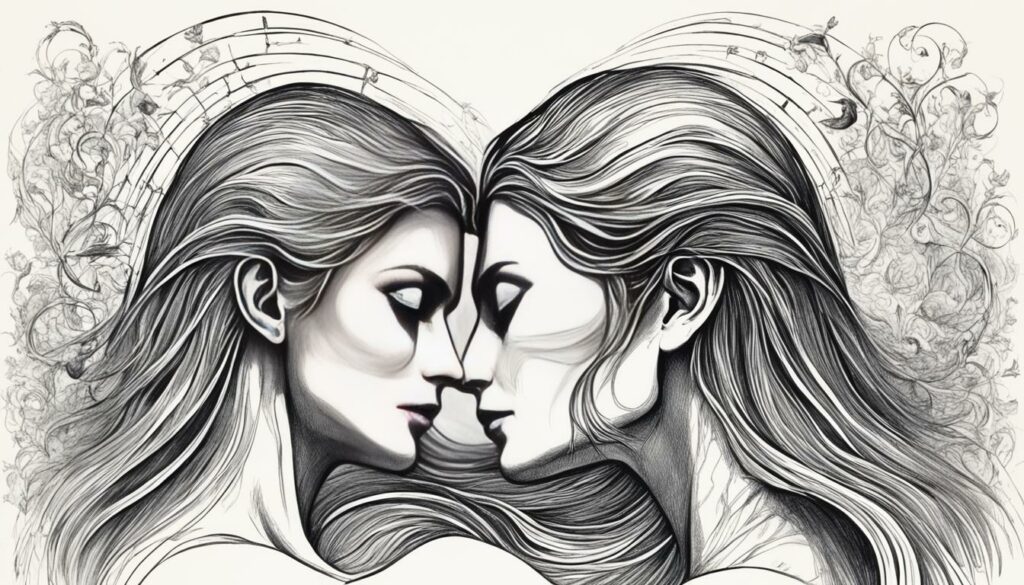
In the Star Wars saga, the characters of Princess Leia and Luke Skywalker exemplify the star-crossed lovers archetype. Unbeknownst to them, they are siblings, and their fateful connection is marked by both tragedy and redemption. Their intertwined destinies unfold against the backdrop of the epic battle between good and evil, embodied in the characters of Darth Vader and Luke Skywalker. The presence of these archetypal characters adds depth and emotional resonance to the narrative.
In the Harry Potter series, the character of Severus Snape portrays a complex and tragic figure. His unrequited love for Lily Potter, Harry’s mother, leads to an unhealable wound. Snape’s redemption and sacrifice embody the archetype of lost love, demonstrating the deep emotional impact that unresolved feelings can have on a character.
The Indiana Jones series features the iconic character of Indiana Jones, who embodies the archetype of the fearless adventurer and treasure hunter. Jones faces numerous challenges and adversaries, in a manner reminiscent of the archetypal hero’s journey. His wit, intelligence, and mastery make him a modern-day embodiment of the legendary hero archetype.
The Role of Archetypes in Human Experience
Archetypes in literature reflect common elements of the human experience. Through stories, archetypes tap into our collective knowledge and shape our understanding of life, heroes, death, power, and emotion. They have the power to evoke deep and powerful emotions within us, resonating with our own personal journeys and connecting us to the broader tapestry of human existence.
Stories have always been a fundamental part of our lives, allowing us to explore different perspectives, navigate complex emotions, and find meaning amidst the chaos. Archetypes serve as a universal language, conveying timeless truths and resonating with our innate understanding of the world.
Whether it’s the hero’s journey, the wise mentor, or the star-crossed lovers, archetypes capture the essence of the human experience in ways that transcend time and culture. They offer profound insights into the complexities of life and provide us with a lens through which we can navigate our own paths.
The Power of Knowledge and Transformation
“The journey of the hero is about the courage to seek the depths; the image of creative rebirth; the eternal cycle of change within us.” – Joseph Campbell
Archetypes offer us a deep well of knowledge and wisdom. They guide us through the narratives of life, teaching us valuable lessons about perseverance, transformation, and the inherent power within us. These stories remind us that while life’s challenges may be daunting, we possess the strength and resilience to overcome them.
Connecting Through Stories
“Stories are a communal currency of humanity.” – Tahir Shah
Stories, with their archetypal characters and situations, provide a powerful means of connection. They transcend cultural boundaries and enable us to recognize ourselves in the experiences of others. Through shared stories, we find solace, inspiration, and a sense of belonging in the vast tapestry of human experience.
Eliciting Emotion and Empathy
“No tears in the writer, no tears in the reader. No surprise in the writer, no surprise in the reader.” – Robert Frost
Archetypes have the ability to evoke profound emotions within us. They tap into the depths of the human psyche, stirring feelings of love, fear, joy, and sorrow. By experiencing the emotional journeys of archetypal characters, we cultivate empathy and gain a deeper understanding of our own emotions and those of others.
Through the lens of archetypes, stories become mirrors reflecting the complexity of the human experience. They empower us with knowledge, compassion, and a profound sense of connection to our shared humanity.
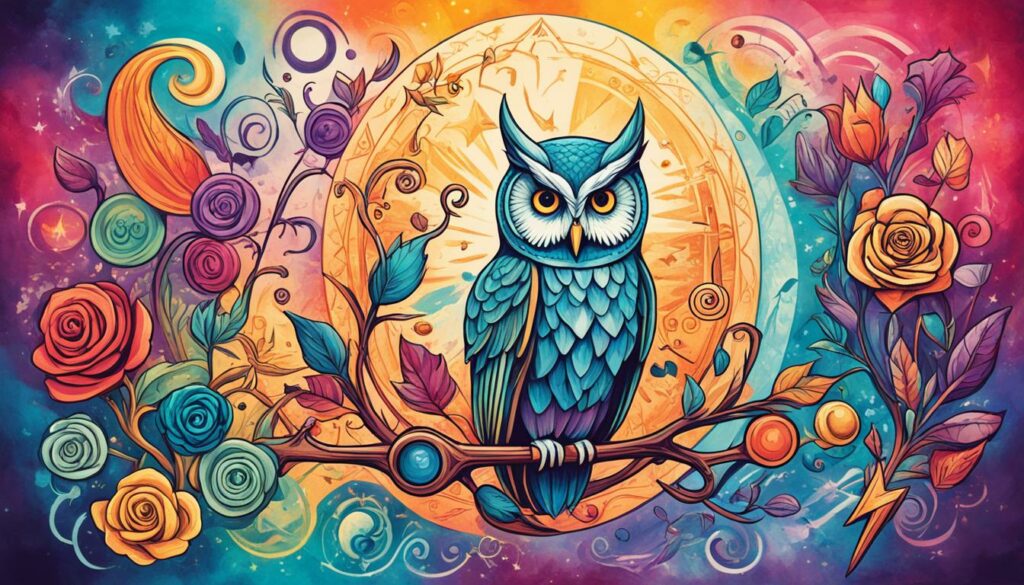
Conclusion
In conclusion, situational archetypes play a significant role in literature, shaping the narratives we read and resonating with readers on a deep level. These archetypes serve as universal patterns, reflecting the human experiences we all share. By understanding and recognizing these archetypes, we gain a deeper appreciation for the art of storytelling and its power to represent and connect us to the world of human experiences.
Literature’s use of situational archetypes allows us to explore and understand various aspects of life, such as the hero’s journey, the mentor archetype, and the symbolism embedded within stories. Through these archetypes, we are able to tap into our collective knowledge and emotions, making literature a powerful tool for self-reflection and personal growth.
Furthermore, situational archetypes provide a framework for representation in literature. They allow authors to create relatable characters, settings, and plotlines that resonate with readers from different backgrounds and cultures. Through these shared archetypal elements, literature can bridge gaps, promote empathy, and foster a sense of connection among diverse audiences.
In summary, situational archetypes form the backbone of storytelling in literature. They provide structure, depth, and meaning, making stories not only entertaining but also insightful and thought-provoking. By embracing the power of archetypes, both writers and readers can embark on a journey of exploration and self-discovery through the rich tapestry of literature.
FAQ
What are situational archetypes in literature?
Situational archetypes in literature are recurring patterns or themes that exist across various stories. They reflect universal human experiences and often shape the plot and characters of a narrative.
What are character archetypes in literature?
Character archetypes in literature are common character types that appear across different stories. They represent specific traits or roles and can include the hero, mentor, villain, damsel in distress, and many others.
What are symbolic archetypes in literature?
Symbolic archetypes in literature are objects, characters, or events that carry deeper meaning and often represent universal concepts or ideas. They add layers of symbolism and contribute to the overall theme of the story.
What is the hero’s journey?
The hero’s journey is a classic situational archetype commonly found in adventure stories. It follows the journey of a hero who embarks on a quest, faces challenges, receives guidance from mentors, and eventually achieves personal growth and transformation.
Who are some famous examples of archetypal characters?
Famous examples of archetypal characters include Luke Skywalker from Star Wars, Frodo Baggins from Lord of the Rings, and Harry Potter from the Harry Potter series. These characters embody the hero archetype and go through significant adventures and personal development.
How do mentors shape the hero’s life?
Mentors play a crucial role in the hero’s journey, providing guidance, knowledge, and wisdom. They often assist the hero in overcoming challenges, acquiring new skills, and finding their true potential.
What are some examples of symbolic archetypes in literature?
Examples of symbolic archetypes in literature include the lion in The Lion King, which represents power and leadership, and the golden snitch in the Harry Potter series, which symbolizes the fleeting nature of life and the pursuit of goals.
What are stock characters and their role in literature?
Stock characters are stereotypical or commonly recognized character types that appear in literature. They may serve specific purposes, such as providing comic relief or representing particular roles or traits, like the character with educated stupidity.
Can you provide some examples of situational archetypes in popular literature?
Certainly! Examples of situational archetypes in popular literature include the star-crossed lovers in Romeo and Juliet, the mentor-student relationship between Princess Leia and Luke Skywalker in Star Wars, and the battle between good and evil represented by Harry Potter’s journey against Voldemort in the Harry Potter series.
How do archetypes connect with the human experience?
Archetypes tap into our collective knowledge, evoking emotions and shaping our understanding of life. By representing universal themes, archetypes help us relate to the characters and stories on a deeper level, touching on aspects of power, knowledge, heroes, and the inevitability of death.




